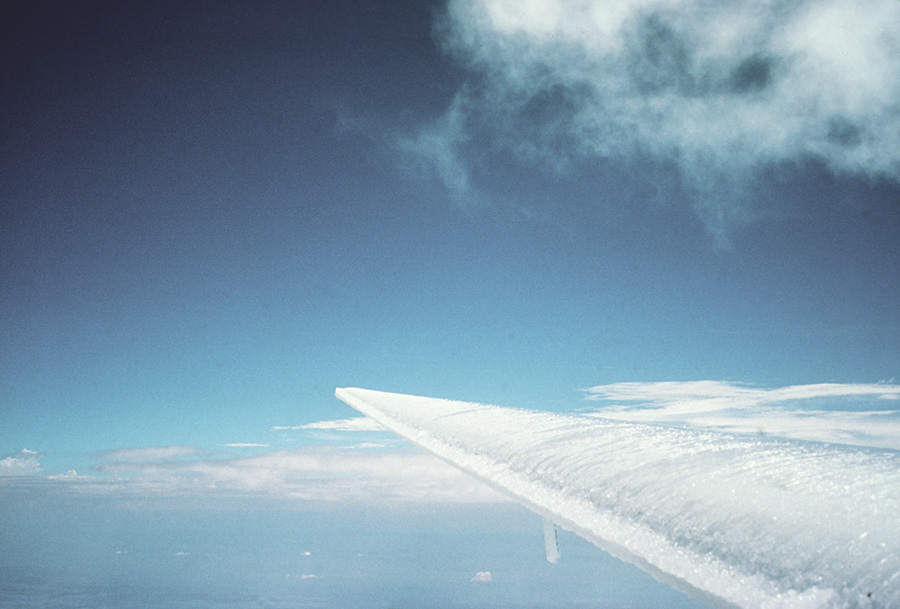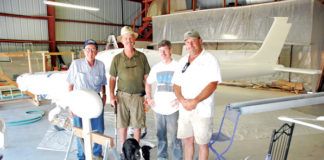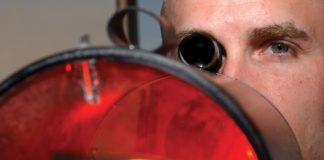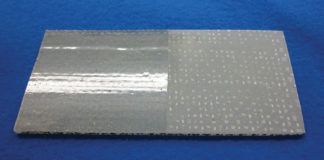“Good judgment comes from experience, and a lot of that comes from bad judgment.”
—anonymous pilot
“There I was,” starts many a fishing tale or a flying story around any EAA Chapter’s picnic table on any given Saturday morning. It’s a time-tested venue for exchanging ideas and learning from each other’s experiences, good and bad. If you can’t get to the airport, or it’s just the middle of the week, you might turn to the aviation forums and listservs online to satisfy the same need.
I’m the first to admit that I lurk on the Van’s Aircraft and RV-10 Matronics lists in an attempt to comb valuable information that I can apply to my own RV-10 flying. It’s a great place to discover how the airplane might behave in flying circumstances I don’t often encounter. One of those conditions is ice.
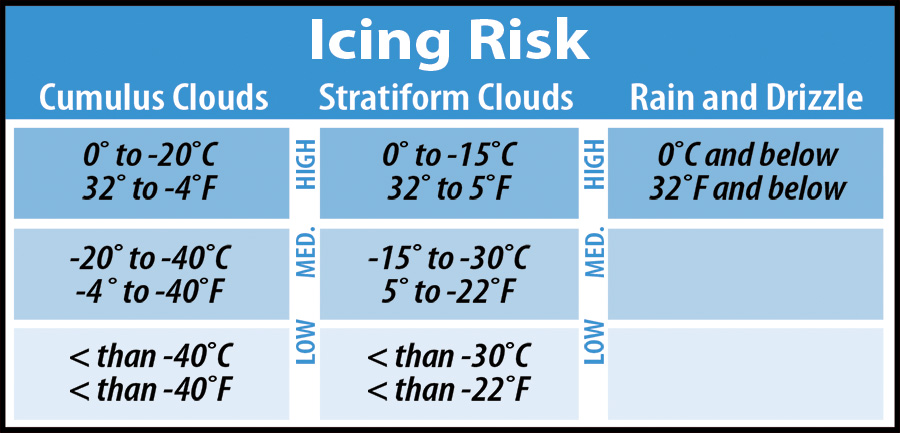
If you spend a lot of time flying in the clouds, keeping this chart handy on your kneeboard might be a useful reminder to keep an eye on the temperature.
Why We Don’t Do Ice
I’m a South Florida lady and so is my fine steed. The aircraft was built here, and there are days when I whine about its windows not opening, its doors that I must have shut for taxi (my arms just aren’t long or strong enough to taxi with them cracked open, and I don’t have any retrofits to prop and hold the door for me), and the “tunnel of heat” that runs between the pilot and co-pilot on the -10. It can make the cockpit hot. Even though the aircraft is plenty warm on the inside, the big fat wing, tapered tips, elevator with horns, and relatively thin horizontal and vertical tail surfaces are just made of .032 aircraft-grade aluminum coated with paint (and not even that much paint). A momentary jaunt through the middle of a building cumulous cloud at the right altitude and outside temperature can easily coat my aircraft in a shiny glazing of thick, clear ice, even at my balmy 30˚ N latitude.
And even a thin glaze of ice can be damaging. I will never forget flying VFR just below a cloud layer in a Cessna 172 many years ago, and picking up a light dusting of rough, white rime ice in the clear air. It was barely an eighth inch and really did not affect the flight capabilities of the aircraft so I thought, how quaint. That was, until I looked back at the Nav antennas on the tail, which were bouncing with ever increasing amplitude—a vibration set up by the airframe and the unbalanced state of the antennas, now weighted with ice. Yikes! I descended in a hurry below the freezing level before an antenna departed the airframe.
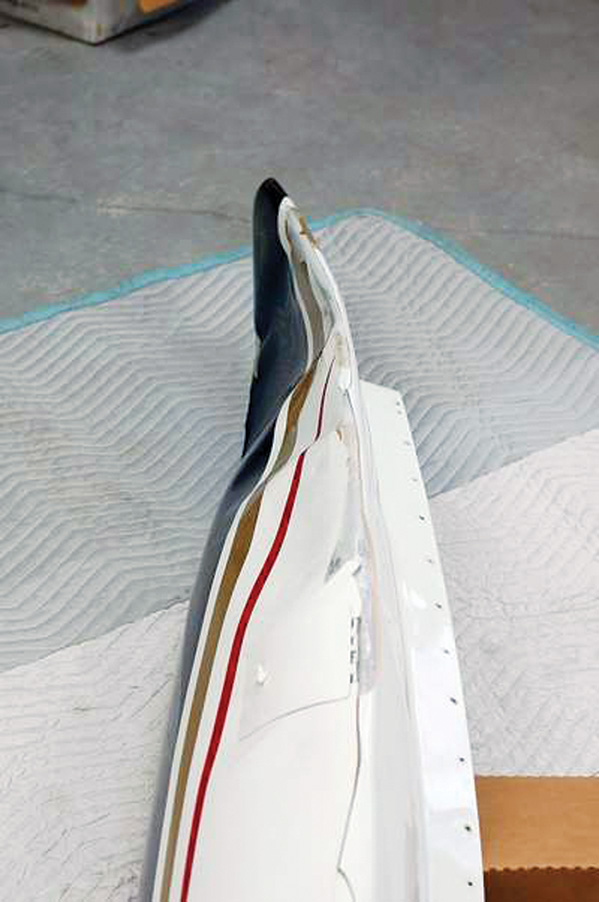
This tip tank collapsed when the vent was plugged by ice. Imagine if this had been an integral wing tank.
Perusing the Van’s Aircraft forums with the search term “icing in flight” lead me to a couple of confessionals from brave pilots. One claimed that it was as if his aircraft had encountered a sudden fire hose of moisture in the tops of a cloud layer at 15,000 feet, coating his aircraft in several inches of ice within a minute or two. Most RVs have a lot of excess power, and this was a particularly well-prepared and experienced pilot (except the part where he found himself inadvertently in icing in an airplane without anti- or de-icing capability). The trim froze, the elevator froze, most likely because of icing in the gap between the horizontal stabilizer and the elevator horns, and it took brute force on the part of the pilot to crack the ice fixing the controls. He descended, diverted, and, carrying extra power, avoiding flaps, he landed safely. He wrote the post to help other pilots make the decision to avoid icing conditions. I copy-pasted the post into my “there I was” file. I don’t want to make those mistakes (Lord knows I am entirely capable of making mistakes of my own).
Avoidance Tactics
I use the Aviation Digital Data Service (www.aviationweather.gov/adds/icing/) charts to view where icing is predicted, and Pireps to tell me where pilots are encountering icing. Unfortunately, forecasts are not guarantees and Pireps are generally old news. I look to see if I’m dealing with a classic cold front, a warm front, or the worst combination, an occluded frontal system, and I decide on a flight track that will have me penetrating the frontal zones at their weakest, during the time of day when the weather along such lines is generally the least active. I try to minimize my exposure to any zone that shows the classic warm over cold air scenario that can lead to icing conditions. All that plus, I avoid freezing rain, drizzle or fog.
In fact, I avoid being in any visible moisture between the temperatures of +35˚ F and -20˚ F. If only that were enough. Ice has been seen to disable aircraft at temperatures much colder than -20˚ F, and it’s a short jaunt from +35˚ F to 32˚ F. My -10 has no anti-ice or de-icing protection short of windshield defrost and a heated pitot tube, and for that reason alone I avoid flying through cold clouds. If I can’t do that, I fly above the undercast as long as I can, as a rule. Altitude and clear air above a cloud layer are your friends when it comes to ice. But don’t settle for bumping along at the cloud tops. Research shows that can be the sweet spot for icing encounters.
NASA literature says that changing altitude by as little as 3,000 ft. can get you out of an inadvertent icing encounter. If you know the temperatures below you are above freezing and the terrain permits, why, by all means, go low. But if you are squeezed by terrain, your best odds are an attempt to climb out of what you hope is a typical icing band. And of course, there is always the option of turning around and going back to where there was no ice. Whatever you do, though, do it quickly.
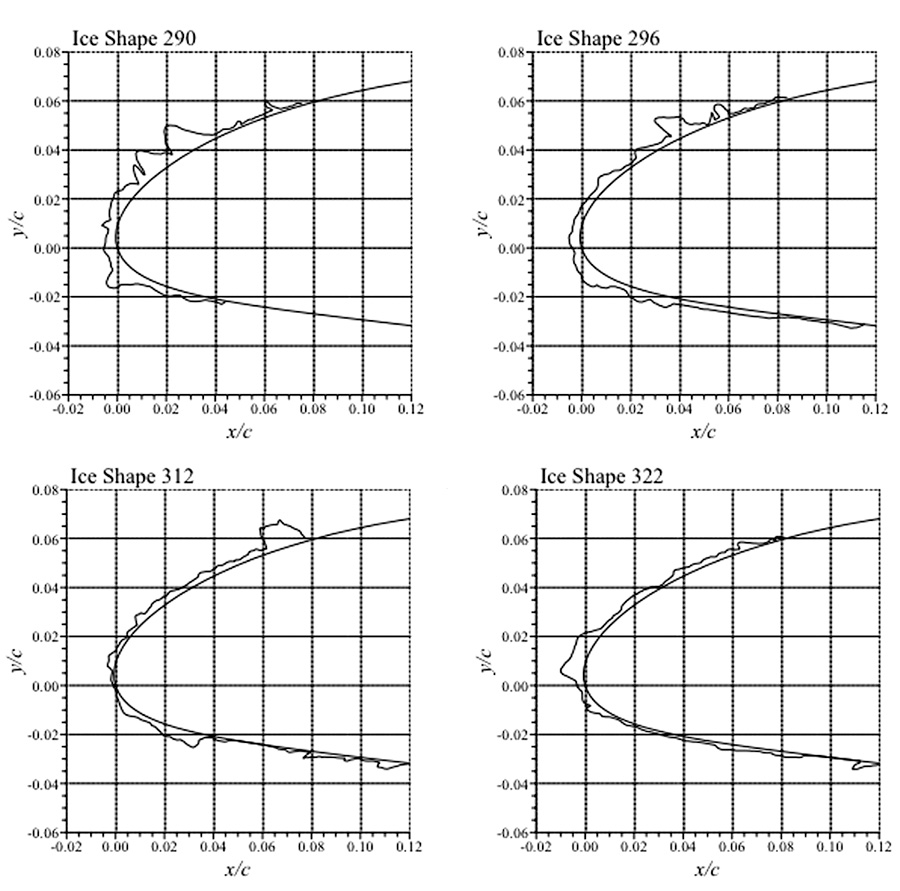
Even minor icing can change the shape of your airfoil significantly. Aside from the weight of accumulated ice, the change to the lift characteristics will make you a test pilot.
Speaking of Rules
In the Experimental world, an aircraft’s operational specifications dictate what it can or cannot do. If yours says no flight in icing conditions, well, that’s the rule. CFR 14 Part 91.527 of the Federal Aviation Regulations does not prohibit Experimental aircraft from flying in known icing. It does clearly state that any aircraft that flies in known icing conditions must be equipped with numerous anti-ice or de-icing strategies. The regulations don’t go into specifics on how to stay ice free, but the technologies for doing so include heated windscreens, glycol sprays for prop, windshield, wings and tail surfaces, or electrically heated, or hydraulically-inflated air-bladder-coated leading edges. And of course, if you are turbine powered there is always engine bleed air for heating air inlets, wings and tail surfaces. You might find this equipment on a tricked-out Lancair Evolution, but probably not on an RV-10.
Performance, Performance, Performance
NASA has spent a lot of time researching the effects of ice accumulation on the flying surfaces and controls of many different types of aircraft. Even though my RV-10 wing is distinctive in its shape and thickness at 16%, it is as vulnerable as the other RV models’ airfoils to the lift deterioration that comes from ice or even frost contamination on the leading edges and wing upper/lower surfaces. Recent wind tunnel studies show that, in fact, the backward streaming of supercooled water droplets that freeze about 20% behind the leading edge cause more lift deterioration than deformative leading edge ice on wings and tail surfaces. And the elevator horns on the RVs are absolute magnets for deformative icing. Canards are not immune, either. Close to 30% of the total drag associated with an ice encounter remained after all the protected surfaces (per 91.527) were cleared.
Where else does ice form fast and disruptively? Fly a twin with alcohol deicing props and you will find yourself jumping out of your skin with every thud of ice shedding off the props and being flung into the fuselage. Remember, propellers are airfoils, too. Deform them and you’ll lose thrust. Unbalance props far enough with weighty ice and you risk a fracture, or worse. Flat discs and horny ridges of ice are known to form on propeller spinners, too.
Finally, all you have to do is fly the RV-10 without gear fairings and wheelpants to understand how nearly every surface of the aircraft presented to the wind is tuned to help fly the aircraft. Now, pollute those carefully-honed shapes with heavy, shape-deforming ice. Can you spell D-R-A-G?
Pilots stuck descending out of the clouds, their aircraft frozen blocks of ice, to the man, describe landing with full power, barely maintaining a speed above stall to the runway. These pilots generally survived because they were smart enough not to apply flaps, which can often induce a tail stall in iced-up conditions. Tail stall recoveries are the exact opposite of wing stall recoveries, and bad things happen fast if the pilot can’t rectify the problem by removing flaps and pulling up on the stick immediately.
Fixes You Can Make
We started this article pointing out that a heated pitot tube is a good thing in moist, cold air. But there’s certainly more you can do without breaking the bank to make your Experimental aircraft safer in the event of an unintended encounter with ice. Consider that a frozen fuel vent is basically a blocked vent. That could lead to a collapsed wing tank, and even a fuel flow stoppage, causing the engine to cease firing. Some pilots who operate in cold air have modified their RV-10 fuel vents with a check valve inside the wing to avoid having them freeze up (Minnesotan Tim Olson’s www.myRV10.com has a great picture of the mod). Our bird has a secondary hole in the vent inside the wing, just in case.
While we are on the subject of air that must flow to prevent engine stoppage, you’ll want to have an alternate air door somewhere, so that if you get air-intake ice your engine can breathe from somewhere. Our engine breather tube also has a secondary hole in it, in case the primary freezes up. Carbureted engine? You’ll definitely need carburetor heat and a willingness to use it.
If you have a static system, make sure to have an in-cockpit static source (we have a valve just like Piper Cherokees have, hand-operated and located just under the instrument panel).
Wheelpants can lead to another classic icing issue: the wheels don’t turn when the aircraft touches down because of ice and/or snow frozen inside. Brakes can freeze up, too. Flying without wheelpants in any Van’s aircraft model costs speed, but it is a consideration if you plan to fly out of snow-contaminated airfields at, or just below, freezing.
And of course, if icy operations are just a fact in the world you intend to fly in, you can attempt to equip your experimental aircraft to shed ice. It won’t be inexpensive, and it will be purely defensive (that means, don’t think you can handle a severe icing encounter—no piston-powered aircraft can). Start with the pitot tube, which should be heated on any IFR-equipped aircraft. Then move to the flying surfaces. There are traditional rubber pneumatic deicing boots or TKS titanium weeping wing/windscreens/props, but that’s heavy. I don’t have a vacuum pump in my all-electric aircraft, and the thought of alcohol or glycol on my paint job makes me wince. I’d go for newer, lighter, electrically-activated heating films you can apply to the tail and wing surfaces to generate heat, and even some cutting-edge devices that use nanotechnology to flex the aluminum skin of the wing just enough to crack ice. Got a composite craft? There are coatings that boast that they can make surfaces slippery to ice, so that it doesn’t adhere as well.
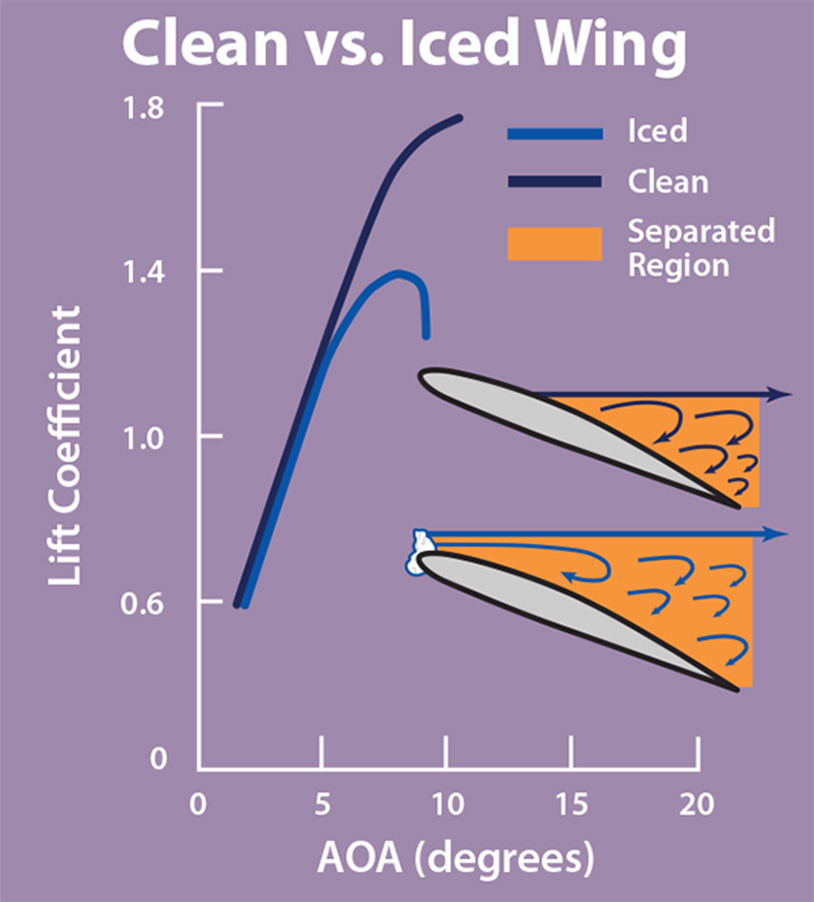
An iced wing will stall at a lower AoA, provide less lift before the stall, and stall more abruptly.
If All Else Fails, Avoid
I started this cautionary tale with a couple of real-life stories about icing encounters. Both my anonymous Experimental aircraft pilot forum contributor and I escaped our icing encounters without damage to life or property. Though the encounters were different in type of aircraft, scope and severity, we both agree: neither of us wants to tangle with ice, not a little, not a lot, ever again.
The best policy for dealing with ice in the sky? Avoid it. Inadvertently find it? Get out of it.

![]()
Amy Laboda has taught students how to fly in California, Texas, New York and Florida. She’s towed gliders, flown ultralights, wrestled with aerobatics and even dabbled in skydiving. She holds an Airline Transport Pilot rating, multi-engine and single-engine flight instructor ratings, as well as glider and rotorcraft (gyroplane) ratings. She’s helped with the build up of her Kitfox IV and RV-10.

